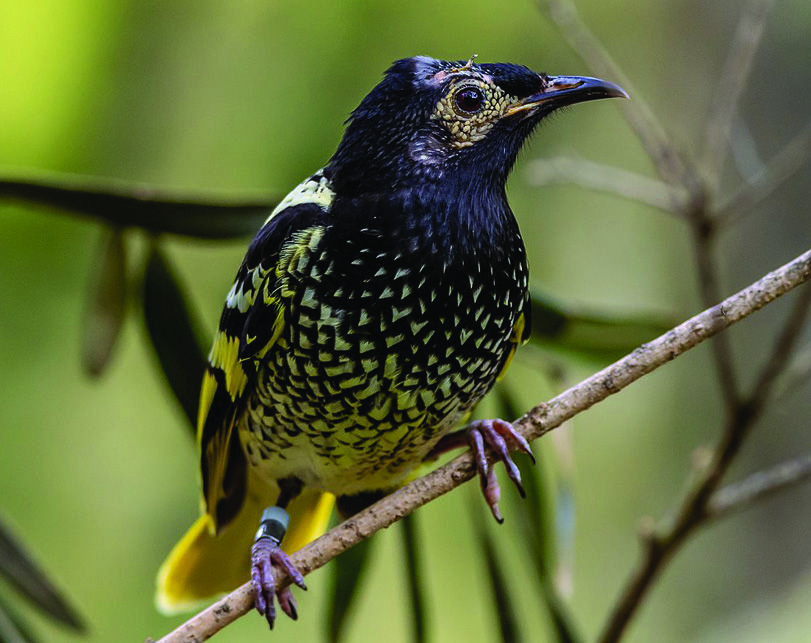
A breeding pair of the endangered Regent Honeyeater has been sighted in the Barraba area for the first time since summer 2016–17. This highly significant sighting is one of the very few known in the whole New England-North West in recent years and was by Stephen Debus.
Stephen Debus has been interested in birds since he was a primary school kid growing up in the Riverina. These days he is an adjunct in zoology at UNE (an honorary research associate position), and is contracted to NSW Local Land Services (LLS) on two biodiversity projects in the region. One is for LLS North West, surveying for the Regent Honeyeater, Swift Parrot and other threatened woodland birds around Barraba. The other is for Northern Tablelands, surveying and monitoring the nests of threatened birds of prey. Stephen is also engaged by BirdLife Australia to conduct the National Regent Honeyeater Monitoring Program surveys at sites between Armidale, Bundarra and Barraba in spring and summer.
The NWLLS woodland bird project started in early 2016 with nine sites in the Barraba district, mainly in travelling stock reserves (TSRs), and has grown to 12 sites with the addition of some extra sites on private land. The survey is quarterly, on a seasonal basis, at each of the sites, so Stephen spends four days around Barraba every three months. Stephen also volunteers on the BirdLife Australia biannual national search days (in May and August) for the Regent Honeyeater and Swift Parrot in the Bundarra-Barraba Key Biodiversity Area (a citizen science program running for more than 10 years). Some of the BirdLife Australia monitoring sites are near Barraba too, visited in spring and summer for over 10 years.
The significant breeding pair were sighted by Stephen last week during a survey of an extensive roadside TSR near, coincidentally, one of the LLS signs about Regent Honeyeaters. “I noticed two birds off to the side of the survey route that needed more attention to identify them,” says Stephen.
“On raising the binoculars I saw they were Regent Honeyeaters – the first I’ve seen in two years, and the only ones in five years of quarterly surveys in that patch. One was gathering nest material before they made a beeline out of sight. Next day I returned and found them attending a nest that was almost ready for eggs.”
Stephen explains that the Regent Honeyeater is found only in south-eastern Australia, and are listed federally and in NSW as critically endangered, meaning they one step off going extinct. “The world population was estimated at about 350 or so birds some years ago, before the devastating 2019 drought and bushfires, so has likely declined further since then, “ explains Stephen.
“They are a beautiful, spangled black and yellow with yellow flashes on the ends of the wings and tail. They were originally seen in flocks of hundreds or thousands, but are now very rare and seen only in small numbers. They signal what is happening to our Australian environment and fauna.”
For NWLLS and BirdLife the focus species are Regent Honeyeater, Swift Parrot (also critically endangered) and the many other declining woodland birds that are listed as threatened (vulnerable) in NSW, such as the Little Lorikeet, Turquoise Parrot, Speckled Warbler and Diamond Firetail, and further north the Painted Honeyeater (nationally vulnerable) in a separate NWLLS project.
Stephen doesn’t just monitor birds during the surveys. “For its relevance to the nectar-feeding birds I also record the occurrence of the flowering of their key eucalypt food trees and mistletoe flowering and fruiting, “ says Stephen. He also looks for birds of prey and their nests surveys for the NTLLS project. The main focus species for that project are the Square-tailed Kite, Little Eagle and White-bellied Sea-Eagle. Stephen also records the Spotted Harrier, Black Falcon and Barking Owl if he encounters them.
Stephen says Barraba people can do some things to help the local birdlife. “As the main problem for all these threatened birds is habitat loss, people can help by protecting native bushland patches, especially mature trees but also regrowth, and restoring and reconnecting bushland with key food trees such as Yellow Box, White Box and Mugga Ironbark according to soil type – use where these trees grow naturally as a guide – especially on fertile flats and along watercourses. But please don’t use barbed wire if fencing off patches,” says Stephen.
River Oak is also a key tree species on creek and river banks. People can also help by reporting illegal activity on TSRs such as firewood theft, and suspected illegal clearing of endangered ecological communities such as White Box-Yellow Box-Red Gum grassy woodland.
“The TSRs in their natural woodland condition are of high conservation value, and deserve management to maintain those values,” says Stephen.
Another problem is nest predation by the Pied Currawong, which has increased greatly because people grow its winter food plants. Stephen says it would help to eradicate introduced environmental weeds such as privet, hawthorn, firethorn, cotoneaster, African olive and pepper tree, and replace them with locally native trees and shrubs.
Stephen also gives a suggestion about pet cats, noting they should be confined to the owner’s property at all times, in a way that prevents access to birdlife. The cats will consequently live longer and healthier lives too,” he says.
Barraba is well known as a “habitat for the Regent Honeyeater”, with the bird featured on signage and on the Finntan Magee mural on the town silos. Stephen has suggested a helpful civic activity that might promote both Barraba and help the Honeyeater. “A series of mini-arboretums featuring the Honeyeater’s favourite food trees could be planted throughout the town’s parklands, “ says Stephen.
Stephen says, “Some of the areas I survey are great birdwatching localities, publicly accessible and featured in the Bird Routes of Barraba brochure instigated by the late Russ Watts, formerly of Barraba and a bird champion, as was his late wife, Jenny nee Bright.”
By Jane Harris



